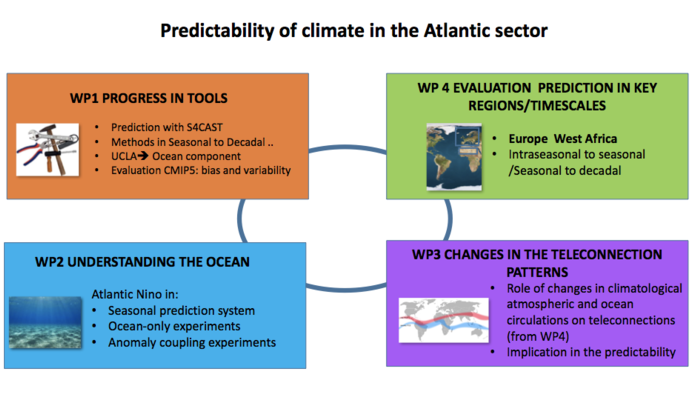PREDICTABILITY OF CLIMATE IN THE ATLANTIC SECTOR (PRE4CAST)

CGL2017-86415-R SPANISH MINISTRY OF SCIENCE, INNOVATION AND UNIVERSITIES
The aim of this project is to evaluate predictability of climate variability in the Atlantic Sector from interannual to multi-decadal time scales, providing an added value. Currently a great amount of data from reanalysis and prediction systems is available. Nevertheless, there is a need to further evaluate such data in a way that it provides robust information about climate predictability and its reproducibility in the operative systems, both at the subseasonal to seasonal and seasonal to decadal scales. Thus, our objectives are to pinpoint geographical regions where skill could be expected, to identify the sources for such skill and mechanisms that provide it, and the possible changes in predictability in time together with the causes for such changes. To do so, we propose a two-pronged approach based on 1) to investigate further the main predictability source for climate variability in the time scales of interest to the project, which include the ocean; and 2) to further develop special tools for research on the subject of climate predictability. These tools include, on the one hand, methodologies to search for potential predictability using statistical and dynamical models. On the other hand, we will improve the coupled atmosphere-ocean model we use to test our hypotheses regarding mechanisms. Specific topics to be addresses are the possible causes for changes in predictability along time associated with anomalies in the movements of the Inter Tropical Convergence Zone. We propose to target two key regions in the Atlantic Sector to provide such predictability studies in which our group has shown broad experience: West Africa and Europe.
PRE4CAST project has enhanced our knowledge of climate variability and predictability over West African and Europe (and some South American regions), as well as oceanic regions in the tropical Atlantic and Pacific basins.
Click here for the complete list of articles derived from PRE4CAST project.
The main outcomes of the project are:
Predictability charts with skill assessment using dynamic and statistic - based predictions.
Related to oceanic variability, dynamics and sea-air interactions, it has been shown that:
- The Atlantic El Niño presents two different configurations during the negative phases of the AMV and in both configurations ocean dynamic processes are relevant.
- The recharge oscillator model shows the best fit to the El Niño phenomenon during the last decades, simplifying in an optimal way the relationship between the thermocline in the West and SSTs depending on the climatological background.
- The Atlantic El Niño can influence its Pacific counterpart during the periods in which the Tropical Pacific shows increased variability and the Tropics are warmer. In addition, The Tropical North Atlantic Mode affects the Pacific El Niño during those periods where the northward heat transport is highest, coinciding with a positive AMV phase.
- The role of surface wind on the Mauritanian-Senegalese upwelling has been highlighted, as well their multidecadal modulations and the influence of El Niño.
- Mauritanian-Senegalese upwelling depends on the sea-land surface pressure contrast as well as on the ITCZ configuration.
- Systematic model biases in CMIP5 simulations affect the representation of the Tropical Atlantic variability.
- Certain climatological oceanic conditions in CMIP5 models favour the correct representation of Atlantic and Pacific El Niños.
- The value of the maximum vertical temperature gradient is a more adequate metric in order to determine the depth of the thermocline in CMIP5 models.
- The reduction of the warm SST biases in the Southern Ocean improves the representation of Tropical Atlantic variability and of the inter-basin teleconnections.
Regarding interannual climate variability in Europe, South America and West Africa, the project has shown that:
- The different configurations of ENSO (EP vs CP) have a distinct impact on Southeast South American rainfall anomalies.
- The effect of SST anomalies related to ENSO, the Tropical Atlantic and Mediterranean basins on Sahel rainfall depend on the period under study and the mechanisms underlying such links have been established.
- The most decisive predictors for the occurrence of extreme rainfall in the Sahel region have been studied, highlighting the fundamental role of El Niño.
- For the first time, transport pathways in the West African Monsoon have been disclosed using a lagrangian approximation.
Regarding ENSO, PRE4CAST has shown that, depending on the period under study, it impacts differently:
- Tropical Atlantic cyclones.
- Maximum and minimum European temperatures in summer and autumn.
- Sahel rainfall.
- European summer extreme rainfall.
Regarding decadal climate variability:
- The late XIX century Sahel humid period has been reproduced with an AGCM forced by observed SSTs, showing that the Atlantic basin was the main cause for it.
- The projected west-east rainfall gradient for the end of this century is mainly control by dynamic changes and not thermodynamic ones.
- The AMV modulates not only seasonal amounts rainfall over the Sahel, but also the number of rainy days and the occurrence of rainfall extremes.
- Changes in the frequency of occurrence of European Blocking and NAO- weather types could be predicted with several years ahead.
Employing current state-of-the-art prediction systems, in PRE4CAST project it has been determined that:
- The Atlantic Niño improves the Pacific El Niño predictions.
- The prediction of SST anomalies in the Mediterranean and Pacific El Niño region as well as the adequate simulation of their teleconnections are fundamental for predicting Sahel rainfall.

